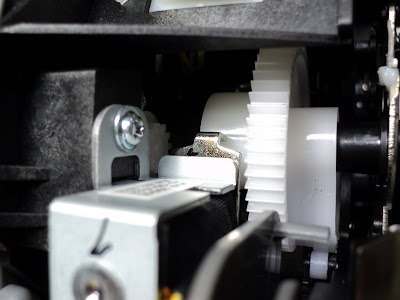It's a straightforward job, but it's quite a teardown to get at the parts.
- - -
Part NumbersPickup Roller Assembly: 12G0067
Main Separation Pad: 12G0062
Left Side Sub-Pad: 12G0119
Right Side Sub-Pad: 12G0120
- - -
Proceed as follows:
1) Front Face-Up Delivery Door
- Unlatch it, and flex it to remove it from its hinges. This is done to make it easy to dislodge the front door when needed. The door interferes with removing the left and right side covers.
2) Cartridge
3) Rear Cover
- Three M3x10mm bright washerhead threading screws.
- Two claws.
- Force the cover upward a bit to unhook it.
- AT REINSTALLATION, mind the parallel interface connector's bails.
4) Top Cover
- Two M3x10mm bright washerhead threading screws.
- The cover lifts away easily.
5) Left Side Cover
- One M3x10mm bright washerhead threading screw at the lower rear.
- One M3x10mm bright washerhead threading screw securing the door's restraint strap.
- One claw next to the printhead.
- Pry at the lower rear to free a retaining nub from a hole in the chassis.
- The lower front is held in place like the lower rear is. The door makes it a bit awkward to get the lower front freed. Dislodge the door's hinge if needed to get the cover off.
6) Right Side Cover
- One M3x10mm bright washerhead threading screw at the lower rear.
- Similar to left side cover.
7) Paper Supply Chute
- Lift it out.
- AT REINSTALLATION, watch that the black mylar sheet in front goes straight into place, and won't interfere with paper motion.
8) Motor/Drivetrain Assembly
- Note the wire and strap connections, and the 'Z'-shaped cable retainer.
- Six M3x10mm black washerhead threading screws.
- Pull the assembly out a way.
- One cable connection at motor.
9) High Voltage Power Supply (HVPS)
- Three cable connections at the upper edge.
- Five M3x10mm black washerhead threading screws.
- Pull the HVPS out a way.
- One cable connection.
10) Spring-Loaded 'Bullet' Contacts
- With the HVPS removed, four contacts are free to come out. Remove them for safe keeping. NOTE that the lower one of the four has a longer spring on it.
11) Printhead w/Mounting Deck
- This item can't be removed entirely because of the way that it's cabled, but it needs to be moved aside for access to the paper pickup area.
- Six M3x10mm black washerhead threading screws, three per side.
- There's a 'hole & stud' retention in front of the fan. Free that and the unit can be lifted away, and lain down behind the printer.
-REASSEMBLY CAUTION: The two upward-pointing 'ears' on the pickup roller assembly
must end up
in front of the lower rear ledge of the printhead deck. The printer will not feed paper otherwise.
- CHECK that the pickup solenoid's flapper hasn't been dislodged after reassembly.
12) Lift Plate Springs
- Unhook them.
13) Pickup Clutch
- One e-clip.
14) Left Side Pickup Shaft Bearing
- Black plastic 'rectangular' baffle plate -- a springy claw is securing it.
- One M3x8mm black pan head threading screw at the ground contact strap.
- Swing-latch bearing -- remove it.
15) Pickup Roller Assembly
- Shift it rightward, free its left side end and remove it.
16) Lift Plate
- Raise it until the flats on its right side pivot pin permit it to come out and away.
17) Main Separation Pad
- Tip it up to where it can come out.
- TRANSFER the spring to the relacement pad.
18) Left and Right Sub-Pads
- A slim spring hook is helpful for unclipping their lower rear edges.
# # #
# # #










thank you!!!!!!!!!!!!!!!!!!!!!!!!!!!!!!!!!!!!!!!!!!!